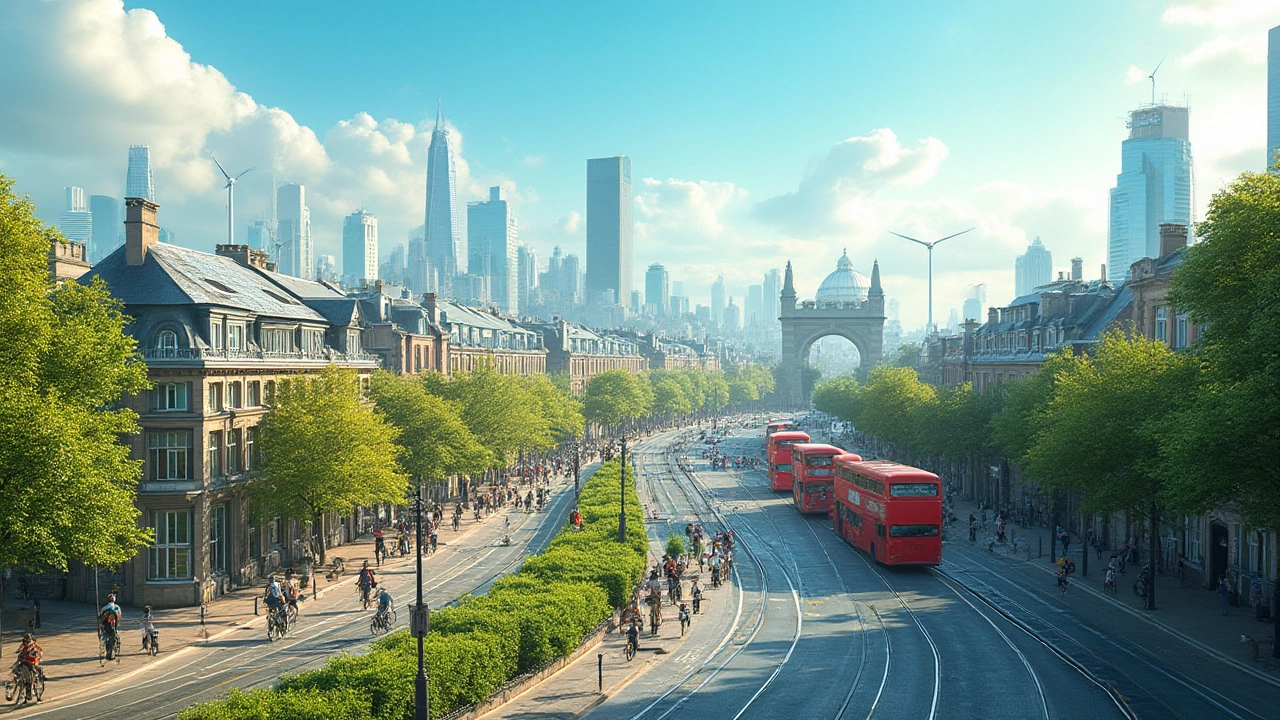Picture this: morning coffee brewed with solar power, walking on a tree-lined street smelling of blooming gardens, and barely any traffic noise – just the hum of a few trams in the distance. Sustainable living isn’t something out of a futuristic movie. There are cities around the world that are seriously nailing it, but not in the ways you might expect. The most sustainable place to live isn’t just about fancy recycling bins or electric buses (though those help!). It’s about communities finding smart and practical ways to support both people and the planet—right now, not in some far-off future.
What Makes a Place Truly Sustainable?
When most people say "sustainable city," the image they have is clean air, lots of cycling tracks, and maybe a weekly farmer’s market. That’s cute, but it only scratches the surface. Sustainability is much bigger. First, it’s an all-in deal: green spaces, renewable energy, access to fresh food, affordable housing, clean water, easy transport, and a community committed to leaving things better than they found them. Not a single area—health, transport, jobs, education—can be left behind.
Every year, the Arcadis Sustainable Cities Index rolls out a detailed report ranking cities on three main pillars: Planet, People, and Profit. How much of their energy is renewable? How is waste managed? What about low-income residents? What’s their carbon footprint per person? If a city’s only sustainable for the rich folks in the leafy suburbs, is it really scoring high?
Let’s talk specifics. Zurich, Singapore, and Stockholm top nearly every global ranking, and you’ll see why. But don’t think size is everything—there are surprising smaller towns leading the way in waste reduction, water treatment, and green buildings. Walkability, protected natural spaces, locally sourced food, and circular economies (where waste from one process becomes fuel for another) play a big part.
Now, think local. How much do residents rely on their cars? Does public transport exist—and actually run on time? Is green energy affordable or just a slogan? And most crucial: do people feel proud to play their part, or is it just city branding?
For example, cities that made the UN’s top-10 sustainable communities list focus on a few gold rules:
- Efficient, accessible public transport run on renewable energy
- High-density, mixed-use neighbourhoods to cut down travel
- Zero-waste strategies: composting, recycling, repair programs
- Affordable and energy-efficient homes for all residents
- Big investment in green spaces and biodiversity
In Amsterdam, nearly two-thirds of trips inside the city are made by bicycle. Freiburg, Germany, has homes powered by solar panels built right into the architecture. Meanwhile in Singapore, they’ve got elevator farms—giant vertical gardens producing fresh food right within city limits. These places aren’t just cutting emissions; they’re reinventing city life to keep residents healthy and happy. And forget the outdated view of "green" meaning dull—check out the pop-up food markets, rooftop bee hives, designer thrift shops, and lively Friday night events in parks that make people want to stick around.
But there’s no point in fancy policies if it’s impossible for locals to keep up. A 2024 UN report found that cities with easy, free recycling stations and subsidies for low-emission transport had far higher community engagement. "Sustainability isn’t just a government mandate—it’s a lifestyle built on collective action," says Irena Jakic, an urban planner in Ljubljana (which, by the way, won Green Capital of Europe a few years ago). Cities that reward residents—like offering free bus rides in exchange for e-waste—see bigger and faster changes.

The Cities and Towns Everyone Is Watching
Let’s get real: everyone’s list looks a bit different, but the data keeps showing some stand-out hot spots. Here’s some hard facts and stories you rarely hear:
- Zurich, Switzerland: Consistently rated the world’s most sustainable city. Zurich has nearly 70% of its power from renewables (mostly hydro) and a strict but easy recycling system. Almost all homes have high energy ratings, and the city invests heavily in public parks—over 40% of urban space is green.
- Stockholm, Sweden: Famous for reclaiming car-dominated zones and turning them into parks and riverside walks. The city’s goal is carbon-neutrality by 2030, and already only 25% of trips are made by car. Children walk or bike to school safely on dedicated routes, and all trash is sorted at home then burned for district heating—zero landfill!
- Vancouver, Canada: Has the lowest per-capita greenhouse emissions among major North American cities. There’s a strong focus on walkability (you can live downtown without a car) and innovative eco-districts. Rainwater harvesting is standard on new builds, and their urban food gardens are managed by community co-ops.
- Singapore: With limited space, Singapore’s government decided to “build up.” Vertical forests, sky gardens, and a water recycling plant that provides 40% of the city-state’s needs. Energy is expensive, but urban farms bring food closer to home, slashing the carbon bill on every salad eaten.
- Freiburg, Germany: Dubbed the “eco-capital” of Germany, Freiburg’s solar district powers itself and exports energy to the grid. Car-free areas, plus tram links that always show up on time. Its housing co-ops even buy solar panels in bulk, making clean energy affordable to renters—everyone wins.
- Wellington, New Zealand: Not a massive city, but bold policies put it firmly on the list. All bus lines converted to electric, powered by wind farms outside the city. Ocean clean-up campaigns and strict rules to protect coastal wildlife. There’s even a "Buy Nothing" community movement that’s become its own kind of local currency.
| City | Renewable Energy (%) | Waste to Landfill (kg per capita/year) | Active Commuting (%) |
|---|---|---|---|
| Zurich | ~70 | 120 | 47 |
| Stockholm | ~55 | 90 | 52 |
| Vancouver | ~30 | 175 | 41 |
| Singapore | ~5 | 320 | 38 |
| Freiburg | ~40 | 100 | 49 |
| Wellington | ~80 | 160 | 40 |
Now the wildcard: some towns like San Sebastián in Spain or Houten in the Netherlands don’t top global lists but have jaw-dropping bike usage rates (over 70%) and barely any private cars; residents breathe cleaner air than almost anywhere. Smaller places often dodge the pressure from big industry and focus on what matters most—community.
But even cities with all-star sustainability records have bumps. Solar panels are great, but if rents soar and families get squeezed out, that’s not success. A universal fact: the most sustainable place to live means nobody gets left behind. Towns with real sustainable chops keep housing affordable—like Vienna’s famous social housing (with rooftop gardens and sharing space), or Copenhagen’s co-living apartments designed from the outset for eco-friendliness and social interaction.
“Resilient cities don’t just survive change—they invent it. Successful sustainability comes down to cities making it easy for everyone, not just a lucky few, to live better,” says Dr. Corinne Vietch, lecturer in urban sustainability at the University of Auckland.
So, there’s no single winner—but there’s a shortlist to learn from:
- Cities that combine green innovation with social inclusion (Vienna, Zurich, Stockholm, Vancouver, Copenhagen, Freiburg…)
- Smaller towns tackling food waste and promoting collective action (like Kamikatsu’s "no waste" village model)
- Communities pushing beyond policy and making sustainability a matter of pride—not just rules

How You Can Make Any Place More Sustainable
If you’re reading from somewhere that didn’t make the global top 5, don’t worry—no place is born sustainable. It’s about what you and your neighborhood can do, right now. Here are practical nuggets that any community can steal from the best:
- Push for better transport. Electric buses not in the budget? Start smaller. Lobby for safe bike lanes, more buses at peak times, or even a community carpool app. Sometimes the local win is better timetables and reliable service. If you love your car, try using it a little less—walk or bike especially for short trips.
- Champion housing that works for everyone. Affordable rent and insulated homes are key. You can back policies for upcycled or modular builds; get involved in co-housing projects, or just help build a thriving local repair café for home appliances.
- Think food miles—and meters. Support local growers. Join or start a food co-op, or turn your verge into a veggie patch if it’s allowed. Some suburbs have trading stalls: bring what you’ve grown, swap what you need—no cash needed.
- Embrace a sharing economy. Host a tool library, clothes swap, or “Buy Nothing” group. If your town or suburb doesn’t have one, grab some mates and set it up. This quickly cuts down on waste and helps you meet neighbors.
- Green your home (however small). Install window boxes for pollinators. Collect rainwater for the garden. Switch to LED lights. Even renters can ask for draft stoppers and switch to renewable energy providers—most power companies offer a green plan if you ask.
- Be a data nerd. The most effective activists collect stats to show what works. Track your household waste or water use, then set goals and share tips. When your council asks for feedback, you’ll have real proof that bigger, smarter changes are possible.
You don’t have to live in Zurich or Wellington to make a difference, either. The best sustainable cities and communities actually started with regular people who asked for simple changes—like longer bus hours, composting stations, or green space upgrades. That’s how things snowball.
Here’s a little-known trick: partner with local schools. Many schools are already working on eco-projects and can help boost community recycling drives or vertical gardening projects. Young people bring fresh energy (and often call out anything that’s just greenwashing!).
And yes—buying things second-hand, eating less meat, and reducing single-use plastics still matter. But connecting those changes to bigger town-wide moves makes your efforts stick. If you want real inspiration, check out the annual Green City Awards or follow the hashtag #SustainableCity on your favorite social platform to see what everyday people pull off.
So if you’re hunting for the most sustainable place to live, sure, check the lists: Zurich, Vienna, Wellington, Stockholm, and more. But remember, the “most sustainable place” is often the one that puts genuine action over glossy branding, lifts up everyone in the community, and makes green living feel less like a duty and more like a celebration. Here’s to hoping your own street gets on the shortlist soon.
